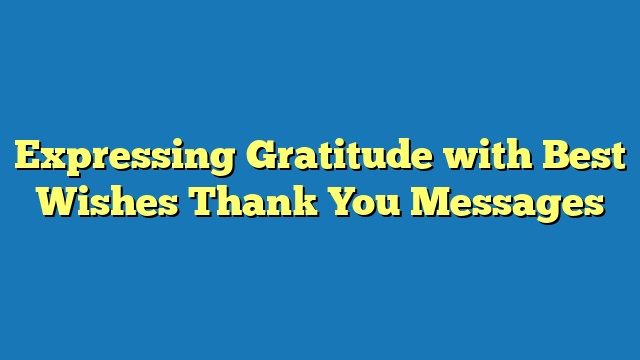Best wishes thank you messages express gratitude and convey well wishes. For instance, an event invitee unable to attend might send a message like, “Best wishes for a successful event!”
Sending such messages is a common practice with both social and professional relevance. It helps maintain positive relationships and make a positive impression. The tradition originated in ancient times when people exchanged letters or gifts to convey their thanks and well wishes.
This article delves into the significance of best wishes thank you messages, their various types, and appropriate usage scenarios. We also explore cultural nuances and provide tips for crafting thoughtful and effective messages.
Best Wishes Thank You Messages
Best wishes thank you messages are an essential aspect of communication, serving various purposes in both personal and professional settings. They convey gratitude, well wishes, and appreciation.
- Conveyance of Gratitude
- Expression of Appreciation
- Building Relationships
- Maintaining Connections
- Professional Courtesy
- Cultural Etiquette
- Emotional Support
- Positive Reinforcement
- Thoughtfulness
- Kindness
These aspects play a crucial role in fostering positive relationships, demonstrating respect, and making a lasting impression. They can be expressed in various forms, including written notes, emails, text messages, and social media posts. The choice of medium and language should be tailored to the specific context and relationship.
Conveyance of Gratitude
Best wishes thank you messages hold immense significance in conveying gratitude. They serve as a powerful means of expressing appreciation, acknowledgement, and recognition for various acts of kindness, support, and assistance received.
-
Expression of Appreciation
Thank you messages convey heartfelt appreciation for thoughtful gestures, contributions, and efforts made by individuals or groups. They acknowledge and validate the positive impact of these actions. -
Acknowledgement of Support
These messages recognize and acknowledge the support received during challenging times or significant milestones. They convey a sense of gratitude for the emotional, practical, or financial assistance provided. -
Recognition of Kindness
Thank you messages serve as a way to recognize and appreciate acts of kindness, both big and small. They communicate that the recipient values the thoughtfulness and compassion shown by others. -
Nurturing Relationships
Expressing gratitude through thank you messages helps strengthen and nurture relationships. They foster a sense of reciprocity and positive regard between individuals.
The conveyance of gratitude through best wishes thank you messages plays a vital role in building and maintaining positive social interactions, fostering a culture of appreciation and respect, and creating a harmonious environment.
Expression of Appreciation
Expression of appreciation lies at the heart of best wishes thank you messages. It is the driving force behind these messages, as they aim to convey gratitude and acknowledge the positive impact of others’ actions. Appreciation serves as the foundation upon which these messages are built, shaping their tone and content.
When expressing appreciation through best wishes thank you messages, individuals acknowledge the value and significance of the support, kindness, or assistance they have received. This acknowledgement fosters a sense of reciprocity and reinforces positive social interactions. Appreciation acts as a catalyst for strengthening relationships and building a culture of mutual respect and support.
Real-life examples of expression of appreciation within best wishes thank you messages abound. A simple “Thank you for your support during this challenging time” conveys heartfelt gratitude for emotional assistance. “I deeply appreciate your thoughtful gift, which brought me immense joy” expresses appreciation for a tangible gesture of kindness. “Your dedication and hard work have made a significant impact, and I want to express my sincere appreciation” acknowledges professional contributions.
Understanding the connection between expression of appreciation and best wishes thank you messages holds practical significance. It enables individuals to craft more meaningful and impactful messages that resonate with recipients. By recognizing the importance of appreciation, individuals can effectively convey their gratitude and strengthen their relationships with others.
Building Relationships
Best wishes thank you messages play a pivotal role in building and strengthening relationships. They serve as a bridge between individuals, expressing gratitude, appreciation, and well wishes. By acknowledging and valuing the positive impact others have on our lives, best wishes thank you messages foster deeper connections and nurture existing ones.
When we express our gratitude through best wishes thank you messages, we demonstrate our appreciation for the support, kindness, and assistance we have received. This acknowledgement reinforces positive behavior, strengthens emotional bonds, and creates a sense of reciprocity. By making others feel valued and appreciated, best wishes thank you messages contribute to the overall health and well-being of relationships.
Real-life examples of how best wishes thank you messages build relationships abound. A heartfelt thank you note for a thoughtful gift signifies our appreciation for the giver’s kindness and consideration. Expressing gratitude to a colleague for their support on a project strengthens our professional bond and fosters a sense of teamwork. Sending well wishes to a friend going through a difficult time demonstrates our care and concern, reinforcing the emotional connection between us.
Understanding the connection between best wishes thank you messages and building relationships is essential for effective communication. By recognizing the power of gratitude and appreciation, we can craft messages that resonate with recipients and have a lasting positive impact on our relationships. Whether it’s a simple “thank you” or a more elaborate expression of appreciation, best wishes thank you messages are an invaluable tool for building strong and meaningful connections.
Maintaining Connections
Best wishes thank you messages are a vital tool for maintaining connections across various aspects of life. They serve as a means to express gratitude, appreciation, and well wishes, thereby strengthening existing relationships and fostering new ones.
The connection between maintaining connections and best wishes thank you messages lies in their ability to bridge physical and emotional distances, convey positive sentiments, and create a sense of belonging. When individuals exchange these messages, they acknowledge the value and significance of their relationships, reinforcing the bonds that unite them.
Real-life examples of maintaining connections through best wishes thank you messages are prevalent. A simple “thank you” note sent to a friend or family member for their support during a challenging time can strengthen the emotional bond between them. Expressing gratitude to a colleague for their contributions to a project reinforces the sense of teamwork and camaraderie within the workplace. Sending well wishes to a loved one celebrating a special occasion demonstrates care and affection, fostering a feeling of closeness despite physical distance.
Understanding the connection between maintaining connections and best wishes thank you messages holds significant practical applications. By recognizing the power of gratitude and appreciation, individuals can craft messages that resonate with recipients and have a lasting positive impact on their relationships. Whether it’s a simple “thank you” or a more elaborate expression of appreciation, best wishes thank you messages are an invaluable tool for maintaining strong and meaningful connections.
Professional Courtesy
In the realm of best wishes thank you messages, professional courtesy plays a significant role in maintaining positive and respectful relationships in various work-related contexts. It encompasses a set of principles and practices that guide individuals in expressing gratitude and well wishes in a professional manner.
-
Acknowledgement of Contributions
Professional courtesy dictates acknowledging and thanking individuals for their contributions, support, and assistance. This shows appreciation for their efforts and reinforces the value of teamwork.
-
Respectful Communication
Best wishes thank you messages should adhere to professional communication standards, using polite language, avoiding offensive or derogatory remarks, and maintaining a respectful tone.
-
Timely Response
Responding to thank you messages promptly demonstrates courtesy and consideration for the sender’s time and effort. Timely responses also indicate attentiveness and value placed on the relationship.
-
Appropriate Medium
Choosing the appropriate medium for conveying best wishes thank you messages is essential. Formal letters or emails may be suitable for business-related messages, while informal texts or social media messages may be more appropriate for personal or less formal situations.
Observing professional courtesy in best wishes thank you messages strengthens professional relationships, fosters a positive work environment, and showcases respect for colleagues and clients. By adhering to these principles, individuals can effectively convey gratitude and well wishes while maintaining a professional demeanor.
Cultural Etiquette
Cultural etiquette encompasses the unspoken rules and norms that govern social interactions within different cultures. In the context of best wishes thank you messages, cultural etiquette plays a crucial role in ensuring that messages are conveyed in a manner that is respectful, appropriate, and aligned with the recipient’s cultural background.
-
Appropriate Language and Tone
Cultural etiquette dictates the use of language and tone that is considered polite and respectful within a particular culture. This includes using formal language in formal settings and informal language in casual settings.
-
Gift-Giving Customs
In some cultures, it is customary to exchange gifts as a way of expressing gratitude. When sending a thank you message for a gift, it is important to be mindful of the cultural norms surrounding gift-giving, such as the appropriate type of gift and the manner in which it is given.
-
Timing and Response
Cultural etiquette also influences the timing and manner of sending and responding to thank you messages. In some cultures, it is considered polite to send a thank you message immediately, while in others it is more appropriate to wait a few days or even weeks.
-
Non-Verbal Cues
Non-verbal cues, such as body language and facial expressions, can also convey cultural etiquette in best wishes thank you messages. For example, in some cultures it is considered polite to maintain eye contact while speaking, while in others it is considered disrespectful.
Understanding and adhering to cultural etiquette in best wishes thank you messages is essential for building and maintaining positive relationships across cultures. By being mindful of the cultural norms and expectations of the recipient, individuals can ensure that their messages are received in a positive and respectful manner.
Emotional Support
Emotional support is a crucial aspect of best wishes thank you messages, as it conveys empathy, care, and a genuine desire for the recipient’s well-being. It goes beyond mere gratitude and encompasses a deeper level of connection and understanding.
-
Empathetic Acknowledgement
Emotional support in thank you messages involves acknowledging the recipient’s emotions, whether they are positive or negative. This shows that the sender understands and cares about the recipient’s experiences.
-
Words of Encouragement
Thank you messages can offer words of encouragement and support, especially when the recipient is going through a difficult time. These messages provide a sense of hope and strength, reminding the recipient that they are not alone.
-
Emotional Validation
Emotional support in thank you messages can also involve validating the recipient’s feelings. This means accepting and understanding the recipient’s emotions without judgment, creating a safe space for them to express themselves.
-
Reminders of Positivity
Thank you messages can serve as reminders of positive qualities, strengths, and past successes. This can help boost the recipient’s self-esteem and provide a sense of perspective during challenging times.
Emotional support in best wishes thank you messages plays a significant role in strengthening relationships, fostering a sense of belonging, and promoting overall well-being. By expressing care, empathy, and encouragement, these messages can make a meaningful difference in the lives of recipients, reminding them that they are valued, supported, and not alone.
Positive Reinforcement
Within the realm of best wishes thank you messages, positive reinforcement plays a pivotal role in strengthening relationships, fostering positive behavior, and promoting overall well-being. The connection between these two elements stems from the fundamental principles of operant conditioning, where positive reinforcement is used to increase the likelihood of desired behaviors.
Best wishes thank you messages serve as a form of positive reinforcement when they acknowledge and appreciate the positive actions, contributions, or qualities of others. By expressing gratitude and well wishes, these messages reinforce the desired behaviors and encourage their repetition. This positive reinforcement can have a profound impact on the recipient, motivating them to continue engaging in positive actions and fostering a sense of accomplishment and self-worth.
Real-life examples abound that showcase the practical applications of positive reinforcement within best wishes thank you messages. A heartfelt thank you note expressing appreciation for a colleague’s exceptional work on a project not only acknowledges their efforts but also encourages them to maintain their high level of performance. Similarly, a message of gratitude sent to a friend who has provided emotional support during a challenging time reinforces their kindness and encourages them to continue being a source of support. These examples demonstrate how positive reinforcement can be effectively utilized to strengthen relationships and promote positive behavior.
Understanding the connection between positive reinforcement and best wishes thank you messages holds immense practical significance. By incorporating positive reinforcement into these messages, individuals can harness its power to shape behavior, strengthen relationships, and create a more positive and supportive environment. Whether it is expressing gratitude for a specific action or acknowledging someone’s positive qualities, positive reinforcement through best wishes thank you messages can have a lasting and meaningful impact on both the sender and the recipient.
Thoughtfulness
Within the realm of best wishes thank you messages, thoughtfulness occupies a central position, shaping their essence and impact. It encompasses a profound consideration for the recipient, their feelings, and the significance of the occasion or gesture being acknowledged.
-
Empathetic Understanding
Thoughtful thank you messages demonstrate an empathetic understanding of the recipient’s perspective and emotional state. They acknowledge not only the action or gift received but also the underlying sentiments and intentions behind it.
-
Personalized Content
Thoughtfulness in thank you messages manifests in the personalization of content. Taking the time to tailor the message to the specific recipient, their interests, and the context of the interaction adds a meaningful touch that enhances its impact.
-
Timely Expression
The timing of a thank you message can convey thoughtfulness. Sending a message promptly shows that the sender values the recipient’s time and effort, while delaying the message excessively may diminish its sincerity.
-
Considerate Choice of Medium
Thoughtfulness extends to the choice of medium for conveying the thank you message. Selecting a medium that aligns with the recipient’s preferences and the nature of the occasion demonstrates a considerate approach.
By incorporating these facets of thoughtfulness into best wishes thank you messages, individuals can elevate their gestures of gratitude, foster deeper connections, and create lasting impressions. Thoughtfulness transforms simple expressions of thanks into heartfelt tokens of appreciation that resonate with the recipient, strengthening relationships and enriching interactions.
Kindness
Within the realm of best wishes thank you messages, kindness stands as a cornerstone, shaping their essence and impact. It encompasses a deep sense of empathy, compassion, and a genuine desire to express gratitude and well wishes to others.
Kindness serves as a catalyst for best wishes thank you messages, inspiring individuals to convey their appreciation and positive sentiments in a heartfelt and meaningful manner. It manifests in the thoughtful consideration of the recipient’s feelings, needs, and preferences, ensuring that the message resonates with them on a personal level.
Real-life examples abound that showcase the practical applications of kindness within best wishes thank you messages. A simple “thank you” note adorned with a handwritten message expressing gratitude for a friend’s support during a challenging time exemplifies the power of kindness. Similarly, a heartfelt thank you message sent to a colleague acknowledging their exceptional contributions to a project demonstrates kindness through its recognition and appreciation of their efforts.
Understanding the connection between kindness and best wishes thank you messages holds immense practical significance. By incorporating kindness into these messages, individuals can create a ripple effect of positivity, fostering stronger relationships, and creating a more compassionate and supportive environment. Whether it is expressing gratitude for a specific act or simply sending well wishes, kindness transforms best wishes thank you messages into powerful tools for nurturing human connections and promoting overall well-being.
Frequently Asked Questions about Best Wishes Thank You Messages
This section addresses common questions and clarifications regarding best wishes thank you messages, providing valuable insights to enhance their usage and effectiveness.
Question 1: What are the key elements of a thoughtful best wishes thank you message?
Answer: Thoughtful best wishes thank you messages consider the recipient’s perspective, personalize the content, demonstrate empathy, and convey gratitude in a heartfelt and sincere manner.
Question 2: What occasions warrant sending a best wishes thank you message?
Answer: Best wishes thank you messages are appropriate for expressing gratitude for various occasions, including personal gestures, professional support, acts of kindness, and special milestones.
Question 3: How can I make my best wishes thank you message stand out?
Answer: To make your message stand out, focus on personalization, specificity, and sincerity. Share specific details about the act or gesture being acknowledged, and express your genuine appreciation.
Question 4: Is it necessary to send a physical thank you card or can I send a digital message?
Answer: While physical thank you cards convey a more formal and personal touch, digital messages can be equally effective in expressing gratitude. Choose the format that aligns best with the occasion and your relationship with the recipient.
Question 5: How soon should I send a best wishes thank you message?
Answer: It’s generally considered good etiquette to send a thank you message promptly, ideally within a week of receiving the gesture or attending the event.
Question 6: What are some common mistakes to avoid when writing a best wishes thank you message?
Answer: Common mistakes include using generic language, focusing solely on the sender’s perspective, and neglecting to proofread the message for errors.
These FAQs provide a comprehensive overview of best wishes thank you messages, addressing common questions and offering practical guidance. Remember, the essence of these messages lies in expressing gratitude, appreciation, and well wishes in a thoughtful and meaningful way.
In the next section, we delve into the cultural nuances associated with best wishes thank you messages, exploring how customs and etiquette vary across different cultures.
Tips for Crafting Best Wishes Thank You Messages
In this section, we present a collection of practical tips to help you craft thoughtful and effective best wishes thank you messages that leave a lasting impression.
Tip 1: Personalize Your Message
Take the time to tailor your message to the specific recipient and occasion. Mention their name, acknowledge their unique qualities, and express your appreciation for their specific actions or contributions.
Tip 2: Be Specific and Sincere
Avoid generic language and focus on expressing your genuine gratitude. Provide specific details about what you are thankful for and why. This shows that you have put thought into your message and that you truly value the recipient.
Tip 3: Choose the Right Medium
Consider the nature of your relationship with the recipient and the occasion when selecting the medium for your message. A handwritten note may be more appropriate for personal gestures, while an email or text message may be suitable for professional or casual situations.
Tip 4: Proofread Carefully
Before sending your message, proofread it carefully for any errors in grammar, spelling, or punctuation. A well-written message conveys professionalism and respect.
Tip 5: Send Promptly
It is considered good etiquette to send a thank you message within a week of receiving the gesture or attending the event. This shows that you are appreciative and that you value the recipient’s time and effort.
Summary: By following these tips, you can create best wishes thank you messages that are thoughtful, sincere, and impactful. Remember, the key is to express your gratitude in a genuine and personal way.
These tips will empower you to craft meaningful messages that strengthen relationships, foster positive emotions, and leave a lasting impression on the recipients.
In the concluding section, we will explore the importance of cultural sensitivity in best wishes thank you messages, highlighting how cultural norms and expectations can influence the way these messages are expressed and received.
Conclusion
In this article, we have explored the multifaceted significance of best wishes thank you messages, encompassing their role in expressing gratitude, fostering connections, and promoting positivity. We have highlighted the importance of thoughtfulness, kindness, and cultural sensitivity in crafting these messages to ensure their effectiveness and impact.
Three key points emerge from our discussion:
- Best wishes thank you messages serve as powerful tools for conveying appreciation, strengthening relationships, and fostering emotional support.
- Thoughtfulness, empathy, and personalization are essential ingredients in creating meaningful and impactful thank you messages.
- Cultural context plays a significant role in shaping the norms and expectations surrounding best wishes thank you messages, and it is important to be mindful of these variations when communicating across cultures.
The thoughtful expression of gratitude through best wishes thank you messages has the power to transform simple gestures into lasting bonds and create a more positive and supportive social environment. Let us embrace the principles discussed in this article to craft heartfelt messages that convey our sincere appreciation and well wishes, leaving a lasting impression on those around us.









Tips for Using "Template by Kevin Crafts" Comments for Meaningful Online Discussions